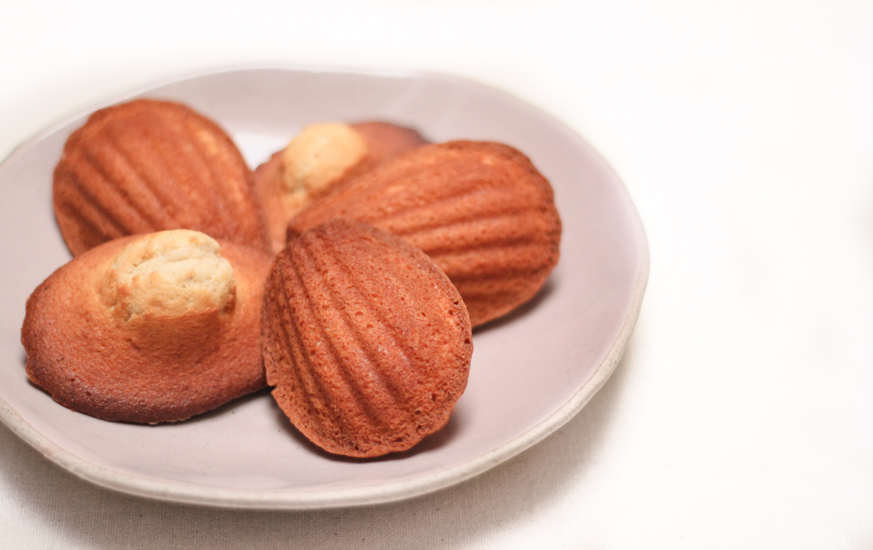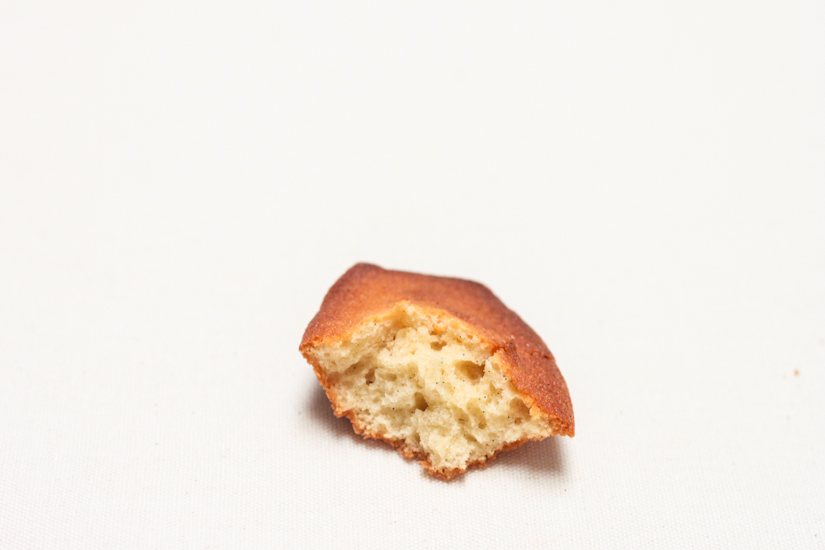I think madeleines go down as my favourite little French cakes.
They are pretty, they are small, and they can be eaten in two bites. That makes them just the right size for me and my reduced sugar cravings (strange how the more I work with sugar, the less I like consuming it.) And what’s even better is that they can be put together in a jiffy.
In my time working at a patisserie, I’ve made countless batches of madeleines. Over time I’ve learned a few lessons and debunked the legendary myth that the madeleine batter needs to be refrigerated overnight to attain those coveted humps.
Let’s get into a few details: Most recipes, especially classical French ones ask for the madeleine moulds to be brushed with beurre pomade or softened butter. This, in fact, is not good (to the shock and horror of my French colleagues). The mould coated in thickened butter has two problems: it holds on to way too much flour when dusted resulting in the flour caking on the madeleine when baked and unmoulded leaving ugly patches of raw flour (this can also happen if you don’t tap off the excess flour properly). Secondly, the chances of the madeleines sticking to the pan are higher. Instead, what you should do is brush a thin coat of melted butter on the pan. Let the butter firm up (or if it’s a warm day just pop it into the fridge for a minute) and then dust it with flour through a sieve. Get rid of the excess flour by giving it a firm tap it on the counter. Make sure every nook and cranny has a film of flour – if not, the madeleines are going to stick to the pan.
Next, it’s important to start baking the madeleines at a very high temperature. This is the key to attaining the hump. For regular sized madeleines, I start baking the madeleine at 210C and then after the humps are visible, I turn the oven down to 180C for it to bake evenly without browning way too much.
This recipe comes from my new favourite blog by Natalie, a pastry chef who studied at Ferrandi and did a stage at Le Meurice. In her post, when she wrote that she begged to differ that Conticini’s celebrated madeleines were the best in Paris, I sat up in my seat and smiled in agreement. And then, of course, I had to try the recipe of the vanilla brown butter madeleines she considered were the best she’s ever had.
These vanilla brown butter madeleines are good. Really, really good. They are best had warm from the oven. This is when the crust is brittle and crunchy and the inside pillow-y soft. The nutty smell of browned butter is a total winner – the kind that should be bottled. Another reason why I love this recipe is because it is so very precise – to the point of telling you that you need to fill 25g of the batter for a large madeleine and 6g for a mini.
And finally, here are some options for getting a madeleine pan (USA | UK | India). Although, not having a madeleine pan shouldn’t deter you – you can pipe them half way up into muffin moulds instead.
Vanilla Brown Butter Madeleines
90g browned butter*
15g wild forest honey
1 vanilla bean
100g plain flour
4g baking powder
70g eggs
25g milk
65g sugar
Directions:
To the warm browned butter add the honey and vanilla bean. Stir to melt the honey. Set aside to cool slightly.
Sift the flour and baking powder together.
In a bowl, whisk together the eggs, milk, and sugar.
Add the dry ingredients into your egg mixture and fold gently till well combined, followed by the browned butter. Mix until just homogenous. Transfer to a piping bag and let it chill for 2 hours or longer.
Preheat your oven to 210C. Grease the madeleine pan lightly with melted butter then dust with flour (read details above). Pipe into the mould and bake for 7 minutes until the hump appears then turn down the temperature to 180C, rotate the pan and bake for another 4 minutes.
* To make browned butter, start with 125g of butter and cook it on a low heat until the milk solids have separated and settled, the butter has lost all of its moisture and is no longer sizzling. Strain it through a muslin cloth and then use 90g of this for the recipe.

